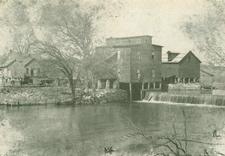Nelson Mill
 From The Ozarks Mountaineer, April 1960, page 5.
From The Ozarks Mountaineer, April 1960, page 5.
by Winslow A. Kingman
"The Nelson Mill goes back for years before the Civil War, but the exact date of its construction is not known. It was located on the James River north and east of Clever, and two and one half miles south of Battlefield. Although the mill was initially owned and presumably built by a man named Griffin, who operated it for some 17 years, it somehow took its name from John T. (Peg Leg) Nelson. He was its owner and operator for many years and until it was destroyed by fire in or around 1910.
A settlement grew up around the mill, consisting of a general store (that also contained the post office), a blacksmith shop and a legal liquor dispensary (plus several on the illegal order). The post office was discontinued soon after the mill burned and was moved to Battlefield, a village that came into being when the Missouri Pacific railway extended its line from Springfield to Crane about 1906.
Grain was first hauled to the Nelson mill on a road or trail which forded the James River just below the mill dam. It was known as the Delaware Indian road and led from an Indian village some three miles southwest of the mill in a north-easterly direction to an intersection with the Old Pioneer road, later known as the Wire road.
John T. Nelson lived four years after his mill burned. He passed on in 1914, at the age of 75 years. He lies at rest in the Manley Cemetery, located less than one-half mile from the mill site. The exact date when Mr. Nelson acquired ownership is not known; however, records disclose that Thomas Jefferson Madison Hawkins moved from Ebenezer to a Robinson mill, near Jamesville, and operated it until it washed away in 1874, after which he ran the Nelson mill for Nelson. About 1906 the old wooden dam was replaced with a concrete dam to check the flow of the stream and provide water-mill power. The latter was washed away some 40 years ago, leaving little or no evidence of the mill, which had existed for so many years.
During the Civil War there occurred a minor skirmish near the Nelson mill between the Union and Confederates forces. General Lyon and his troops came into contact with a detachment of Confederates, who were busily engaged in shoeing their horses at a point near the mill. Another historical incident relates that General Siegel with his troops (on retreating from Wilson Creek Battle, fought several miles distant) swam the Nelson Mill pond because they feared to cross the stream at the place where the customary ford was located.
'Peg Leg' and his mill have been gone to their reward for a half century but both are remembered because they played a big part in the early history of Christian and Greene counties."
According to the 1912 plat book for Christian County, John T. Nelson owned over 273 acres of land in the fifth section of Township 27, Range 22, part of which spanned the James River. The mill was probably located near the modern bridge on North Nelson Mill Road near Wilson's Creek Battlefield. For more mills see the book Historic Ozark Mills by Mike McArthy that, in addition to great photographs, also includes a driving tour map of existing mills.
Find this article at http://thelibrary.org/blogs/article.cfm?aid=664&lid=37&view=print